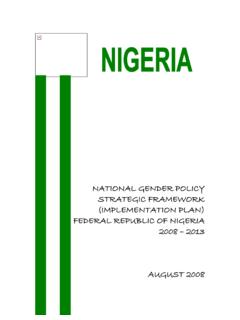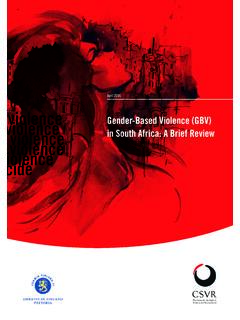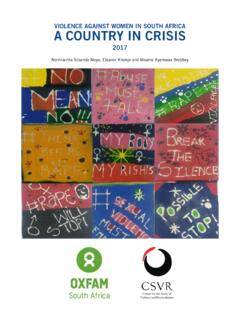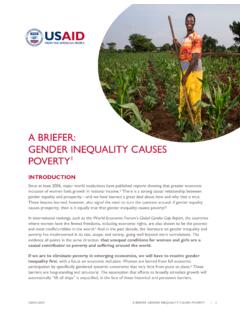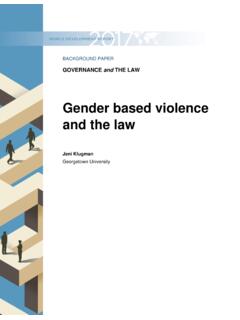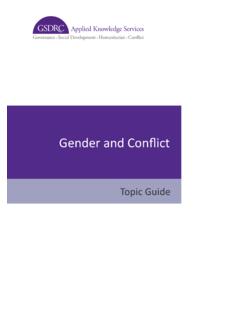Transcription of DISABILITY AND GENDER-BASED VIOLENCE. - ADD …
1 DISABILITY AND GENDER-BASED INTERNATIONAL S LEARNING , EQUALITY AND OPPORTUNITY FOR DISABLED PEOPLE LIVING IN S TIME TO MAKE PROTECTING WOMEN AND GIRLS WITH A DISABILITY A GLOBAL one in five women worldwide is a woman with a DISABILITY . For women with disabilities, GENDER-BASED violence is often compounded by DISABILITY - based discrimination. Women with a DISABILITY are often considered weak, worthless and in some cases subhuman by their societies - and because of that face a heightened risk of domestic and sexual violence . Unfortunately, too many existing programmes meant to prevent GENDER-BASED violence do not take into account the unique dangers and challenges faced by women with disabilities. Without specific attention and solutions, these women have been left behind and at risk. This has to agencies, power holders and service providers need to build into their programmes the right protection for disabled women.
2 It will require sustained global focus, momentum and action. But if we are serious about fulfilling the aspiration to leave no one behind then it has to be done. This paper outlines the lessons we have learned from our work to help guide a collective path forward. WHO WE International is a DISABILITY rights organisation. We partner with organisations of DISABILITY activists in Africa and Asia and help them access the tools, resources and support they need to build powerful movements for change. Over the last 30 years we have supported women with disabilities to either set up their own activist organisations or to create dedicated women s departments in existing groups. We have seen women with disabilities become stronger, more empowered and outspoken. ADD International has both participated in, and led, initiatives to highlight the intersectional discrimination of women and girls with disabilities and highlight their high risk to violence and low visibility in programmes and services addressing the issue.
3 Our work is guided by the UN human rights instruments and more particularly by the UN Convention on the Rights of Persons with Disabilities. gender equality is one of the general principles of the convention and reinforced in article commissioned this review in response to the prioritisation of GENDER-BASED violence as a sector-wide development issue. We wanted to collate insight from our GENDER-BASED violence work to inform our own practice and to support other agencies in implementing effective ON PHOTOS. Please note the photos in this report are not of victims of violence but female DISABILITY activists that ADD International works with. For ethical and safeguarding reasons we do not publish the photos of victims of violence . GENDER-BASED violence refers to violence that targets individuals or groups on the basis of their gender . It is an expression of the power inequality between genders and how women and girls are perceived in their society.
4 GENDER-BASED violence fuels gender inequality by keeping women and girls subordinate and under the control of men. violence against is about power relations between men and women in relation to constructed male/female social identities and roles, so it follows that violence which is based on gender can potentially affect men as well as women. There is evidence that men and boys can be harassed, beaten, raped and killed in armed conflict1 or because they do not conform to the prevailing view of masculinity within their In some cases sexual violence against men is used to punish, oppress and intimidate men because it diminishes their sense of and Indirect European Institute for gender Equality (EIGE) distinguishes between two forms of violence : direct violence which includes physical, psychological, and economic violence perpetrated by individuals and often condoned or even justified by society; and indirect violence which represents a type of structural violence , characterised by the norms, attitudes and stereotypes around gender that operate within a larger societal context.
5 Indirect violence creates and perpetuates attitudes and stereotypes that normalise violence against The UN Special Rapporteur on violence against women describes institutional or structural violence as any form of structural inequality or institutional discrimination that maintains a woman in a subordinate position, whether physical or ideological, to other people within her family, household or community. (Report of the Special Rapporteur on violence against women 2011).1. Sivakumaran, S. Sexual violence against men in armed conflict; 2007 ; , psychological, and economic violence perpetrated by violence characterised by the norms, attitudes and stereotypes around gender that operate within a larger societal has its own stigma, pervasive in every society, but in parts of Africa and Asia discrimination towards disabled people can be particularly oppressive.
6 In areas where research and technology aren t readily available people can t access explanations for conditions. This lack of understanding can cause misconceptions about DISABILITY with devastating consequences. Disabled people are often considered weak, worthless and in some cases subhuman by their societies. DISABILITY - based violence is linked to this social stigma and the power imbalances between persons with and without disabilities. Some societies view DISABILITY as a curse, or a punishment from God. Consequently, persons with disabilities may be reviled or pitied, but are overall not considered as persons deserving equal DISABILITY - based violence occurs in very similar forms to GENDER-BASED violence , on a physical, psychological or economic level, directly and indirectly. Abuse and discrimination of persons with disabilities by medical professionals is commonplace.
7 What is often masked as good intentions are, in fact, acts of serious discrimination and violence , for example intrusive and irreversible treatments without informed consent, such as forced sterilisation and abortion. Equally, withholding appropriate treatment based on DISABILITY -related prejudice and misconceptions, for example in the context of HIV/Aids, is a form of violence by Invisible intersection between DISABILITY and GENDER-BASED violence is of particular concern because some forms of violence against women with disabilities have remained invisible and have not been recognised as GENDER-BASED violence due to DISABILITY discrimination. Women with disabilities around the world experience much higher levels of physical, sexual, and psychological violence , for longer periods of time and with worse physical and mental outcome as a consequence of violence than women without The main factors for the additional vulnerability of women and girls with disabilities are:Patriarchal attitudes: Attitudes towards women in patriarchal societies combined with vulnerabilities related to the impairment itself.
8 Powerlessness: The perceived powerlessness of women and girls with disabilities who are less able to defend themselves or seek support because of their isolation they may be hidden away, the nature of impairment leaves them isolated, or they may not recognise that what is happening is unacceptable and not their to services: Their inability to access legal protection and redress because services are not accessible, because there is lack of awareness of the issues that women and girls with disabilities face in regard to their vulnerability. 1. Document on violence against Women with Disabilities, International Network of Women with Disabilities, 20102. Document on violence against Women with Disabilities, International Network of Women with Disabilities, 20103. Vallins, N., Walji, F. Triple Jeopardy Policy Brief, AusAID, 2013, Working Group on violence Against Women with Disabilities, Forgotten Sisters , 2012 Vulnerability in conflictViolence linked to reproductive rightsBarriers to supportMyths about sexualityViolence in daily lifeHigh incidence of rapeDISABILITY AND GENDER-BASED FROM OUR ADD International we believe the strength of an organisation lies in part in its ability to learn from its experience and to feed this learning into improved practice.
9 The purpose of this review is to examine the lessons we have learned from our GENDER-BASED violence work with women and girls with disabilities. In this paper we highlight the following key expressions of violence which particularly impact women with disabilities:Sexual & Physical violenceEconomic violencePsychological violenceViolence against men and boysExclusion from powerSEXUAL AND PHYSICAL HIGH INCIDENCE OF RAPE. Global data on GENDER-BASED violence against women with disabilities is limited, which in itself speaks to the global inertia on this invisible crisis. The limited data available suggests higher risks for women with impairments. The Working Group on violence Against Women with Disabilities, Forgotten Sisters (2012) cites international studies which have concluded that women with disabilities suffered an equal, or up to three times greater risk of rape, by a stranger or acquaintance, than their non-disabled research study in Cambodia confirms that women with disabilities experience much higher levels of family violence .
10 They are much more likely to be insulted, made to feel bad about themselves, belittled, intimidated, and subjected to physical and sexual violence than their non-disabled peers .2 Sexual and physical abuse often comes from family members, carers/personal attendants, or partners on whom the women or girls with disabilities Bond DISABILITY and Development Group (2013), Submission to the International Development Select Committee Inquiry on violence Against Women 2 Research Policy Brief: Triple Jeopardy; violence against women with disabilities in Cambodia3 Bond DISABILITY and Development Group (2013), Submission to the International Development Select Committee Inquiry on violence Against WomenIn order to mitigate the risk of sexual violence , disabled women need to have greater means of independence. In 2013 we supported DISABILITY activists in Northern Uganda to deliver a 3-year GENDER-BASED violence project.
